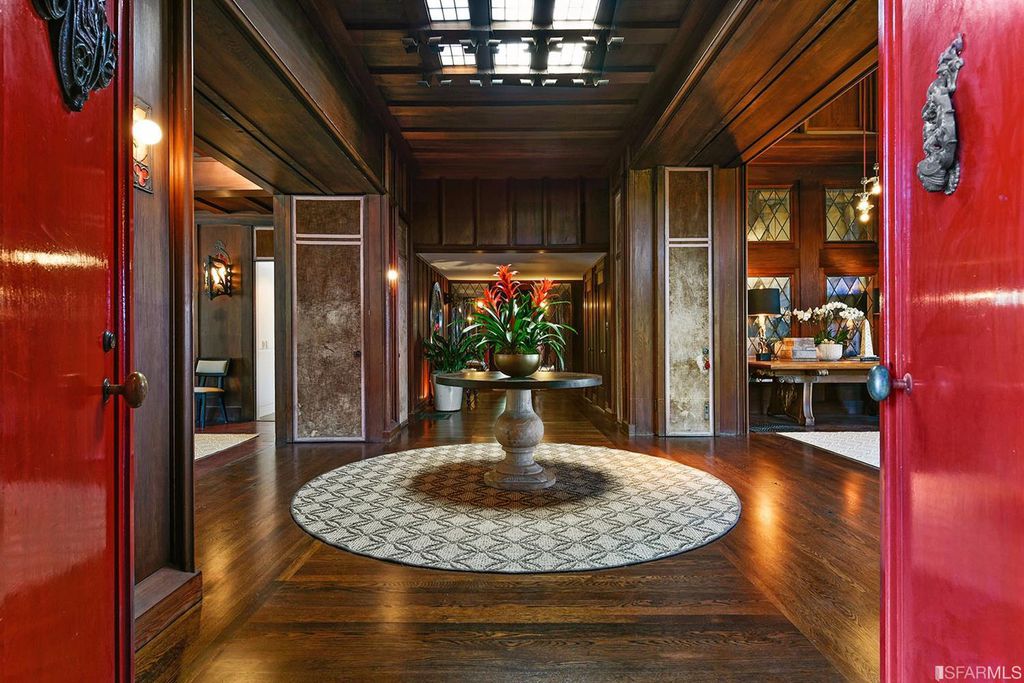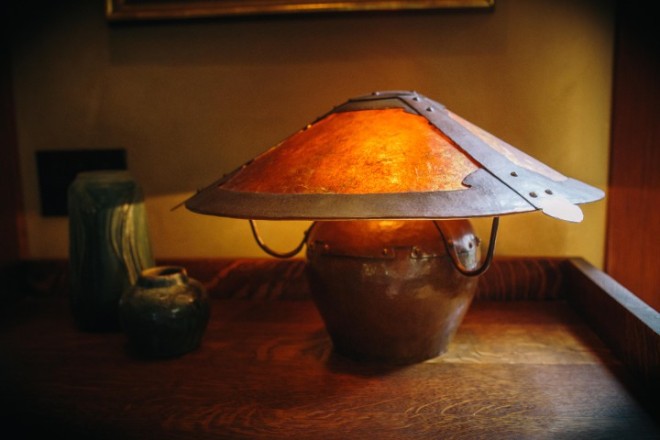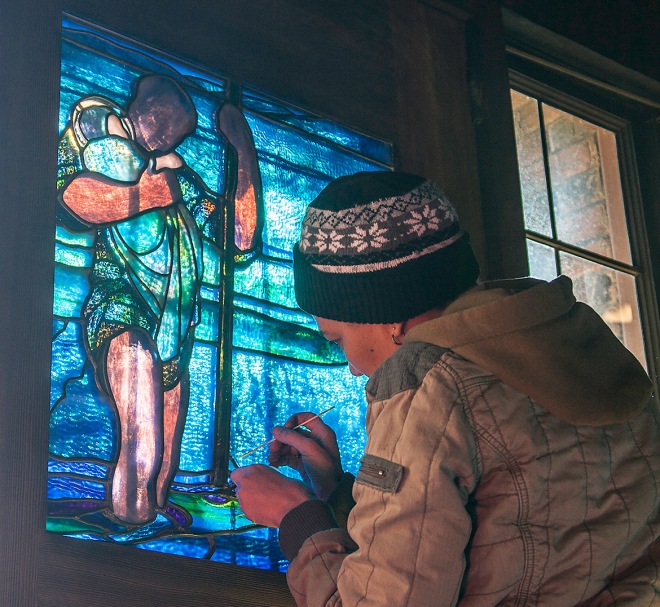Making a move
July 1, 2020 § 1 Comment

“COMMENCE AGAIN,” the great early California artist Arthur Mathews instructed his students as he tossed their drawings into the dustbin. We are taking his advice, and are delighted to relocate ourselves and our gallery to beautiful and historic Santa Barbara, where we will continue to exhibit work online and by appointment, perhaps with the occasional pop-up when the fates allow.
We are especially happy to be in the area of California’s Central Coast where HENRY VILLIERME created most of his work. Henry lived in nearby Ojai for more than 50 years after being anointed as one of the original group of 12 artists who became known as the Bay Area Figurative painters after a 1957 exhibition at the Oakland Museum.

We’re also happy to be bringing SANDY OSTRAU back to Santa Barbara. Sandy is a proud graduate of UCSB, where she was a big star on the soccer team. Her juicy paintings of the California coast — north, central and south — are among the most exciting works of our time.
And while KEN AUSTER perfected his of-the-moment style painting the streets, bars and restaurants of San Francisco and New York, he worked and surfed at points farther south near his home in Laguna Beach. We’re happy to continue to offer work from the occasional estate and from his own.
— Thomas Reynolds
‘Commence again’
May 22, 2020 § 1 Comment

By HARVEY L. JONES
Arthur F. Mathews’ well-deserved reputation as a hard master was revealed in his frequently harsh criticism and caustic comments about the students’ work. Although they regarded him with fear and awe, the students in his drawing classes were noted for the high quality of their draftsmanship.
As it was in the Parisian art academies, Mathews met with his classes twice weekly for the purposes of instruction and review of the students’ accumulated work. He had little patience with the untalented and was known to ignore some of the students working at their easels, making neither comment nor criticism for days or weeks at a time, as a way of discouraging all but the most diligent and dedicated in the class. Those students who aspired to Mathews’ high standards were rewarded with his generous attention and encouragement.
Despite his dictatorial teaching methods, Mathews did not expect the students to imitate his own approaches or themes. Moreover, during his 16 years as director of the California School of Design in San Francisco, he always advised his best students to seek further study in Paris. Mathews was also very supportive of the efforts of women in the arts.
A large number of California’s best artists, both men and women, from the first half of the 20th century were his students. They include, among many others, his wife Lucia Kleinhas Mathews, Armin Hansen, Florence Lundborg, Francis McComas, Xavier Martinez, Anne Bremer, Gottardo Piazzoni, Ralph Stackpole, Giuseppe Cadenasso, Isabel Hunter, Granville Redmond, Joseph Raphael and Euphemia Charlton Fortune.
— Excerpted from The Art of Arthur & Lucia Mathews by Harvey L. Jones (Pomegranate 2006), published by the Oakland Museum.

FLW tiles in Taliesin red
December 22, 2019 § Leave a comment

Frank Lloyd Wright’s signature red tile.
ARCHITECT AARON GREEN, who lived in an apartment overlooking San Francisco’s Lafayette Park for many years, helped Frank Lloyd Wright establish an office here in 1951 at 319 Grant Avenue.
Green’s mother-in-law, Jeannette Pauson Haber, lived near him at 2510 Jackson Street, on Alta Plaza Park, with her sister, Rose Pauson, who was a former client of Wright’s. In 1940 she had built the Pauson House in Arizona, which was destroyed by fire in 1943.
Rose was a painter, and Jeannette a ceramicist. When Wright decided to create red tiles, inscribed with his initials, to be affixed to a select number of his buildings, he asked Jeannette to fabricate them. Wright provided a drawing of what he wanted; Jeannette formed the tiles; Aaron Green inscribed the initials — FLLW — into each one; and Jeannette produced the “Taliesin red” glazed surface that Wright specified.
Among the Bay Area buildings that Wright designated as worthy of bearing the tiles were the V.C. Morris shop on Maiden Lane — his only building in San Francisco and a precursor to the circular Guggenheim Museum in New York — and the Marin County Civic Center, which was completed by Aaron Green after Wright’s death.
— From Frank Lloyd Wright and San Francisco, by Paul V. Turner, published by Yale University Press.
Art and life and death
August 12, 2018 § 1 Comment
I’D HAD COFFEE with Kelly Johnson — or at least said hello — almost every day for many years. He was a regular at Peet’s on Fillmore, our neighborhood gathering place, with tales to tell from his colorful artistic life as a childhood vaudeville star who later created a modern dance studio on Fillmore Street, helped put the Berkeley Symphony Orchestra on the map, and was himself a dancer and a concert pianist. One day in April he called and asked me to come by his third-floor flat, less than half a block from our usually sunny coffee corner.
We’d talked a few times about my interest in hand-hammered copperwork from the Arts & Crafts era. He’d told me he knew Armenac Hairenian, a noted coppersmith whose shop was just across the street from his flat. He had a pair of copper candelabras Hairenian made for him half a century ago as a birthday gift. He’d promised to invite me over and show them to me, and I was looking forward to it.
I climbed the stairs to his flat and found Kelly sitting on the red couch in his round-bayed living room overlooking the heart of Fillmore Street. It was a beautiful old rambling Victorian flat he’d called home since 1969. His daughter was visiting, and she brought in the candelabras. “I want you to have these,” he said. As he was telling their story and recalling the many dinner parties on which they cast their glow, I pulled out my iPhone to record his recollection of this important but little-known coppersmith. Kelly was one of the few people left who remembered him.
THEN HE DROPPED A BOMBSHELL. I knew Kelly was not well, and that it was increasingly difficult for him to leave his apartment, even to go to Peet’s. He said he was giving away a few choice possessions, and that his daughter had come home to help him die. He had decided to end his life on May 7 under the procedure authorized by California’s new End of Life Option Act.
Moved and shaken, I went back to my office and put together a short video about the candelabras. It was a bittersweet project that would also save a memory of Kelly in his final days. But I knew I was not telling the most important story I had heard that day. So I asked Kelly if I could come back and make another video, this one about him and his decision to end his life.
Kelly was game. He’d been a performer all his life, and he had a message he wanted to share. The video turned into a much more elaborate production capturing Kelly’s final two weeks and the end of his life. It was an intense project created with a talented young journalist, photographer and filmmaker fate brought along at just the right time. A Dance With Death premieres at 7 p.m. on August 15 — three months after Kelly died — at our century-old neighborhood theater, located on the same block where Kelly lived for half of its history.
— Thomas Reynolds
Maybeck’s Roos House changes families
February 11, 2018 § 1 Comment
IN THE dwindling days of December, an historic Presidio Heights Tudor sold for the first time — ever — making it the biggest single-family home sale of 2017 in San Francisco.
Bernard Maybeck’s Roos House, at 3500 Jackson Street, sold for $11 million, down from its original asking price of $16 million. Since its construction in 1909, the home had been passed down through family members, making this its first-ever sale.
♦
“Architecture is Life-Poetry,” Maybeck once said, quoting Louis Sullivan. The house Maybeck designed in 1909 for the Leon L. Roos family “was definitely Life-Poetry,” wrote Sally Woodbridge in her definitive book, Bernard Maybeck: Visionary Architect.
Woodbridge wrote of the Roos House:
In Mrs. Roos, Maybeck had a client whose interest in theater paralleled his own. The house was a wedding present from her father, Morris Meyerfeld, who was a partner in the Orpheum Theater Circuit company. He had taken Elizabeth Leslie with him when he traveled to Europe in search of talent, and these tours gave her a lasting enthusiasm for the theater and for theatricality. When she heard that Mr. Maybeck designed theatrical houses, she rejected the architect her father had chosen and hired Maybeck.
The skylit entrance hall of the Roos House.
At about 9,000 square feet, this is Maybeck’s largest San Francisco residence. It has two distinct sections: a two-story front part with dining room, entrance hall, kitchen and service spaces on the ground floor and bedrooms above; and a back part with only one floor but nearly the same height as the front part. The back part contains the great two-story living hall, the largest room in the house. Though difficult to ignore for other reasons, the house does not immediately reveal its considerable size. Instead of the grand entrance typical of mansions of the time, the front door is at the end of the loggia on the east side of the house, and it is not visible from the street.
The Roos family entertained frequently and formally. Their guests would approach the house through the loggia, which serves as an open foyer, and enter the low-ceilinged, skylit entry. From this point the sequence of spaces along the lengthy north-south asix is visible. The passage from the dining room at the front to the secondary living room, or alcove, at the back is also a progression from the closed and private street side to the more open garden side. The low-ceilinged alcove is a setting for contemplation of the view through the large window overlooking the Presidio grounds and Marin County across the bay.
While the guests proceeded into the living hall, the hosts would descend from the upper floor by means of a stair hidden behind a wall and appear on a stagelike landing to greet those assembled in the hall. The landing, raised four steps above floor level, forms one end of a cross axis anchored on the opposite side of the room by a caststone fireplace that rises to the ceiling. After making an initial appearance, the hosts would usually stand by the hearth and receive their guests less formally. Dr. Jane Roos, who inherited the house in the late 1970s, recalls that she first saw her mother-in-law dressed in a tea gown, standing by the fireplace.
The Rooses had a wonderful time living a baronial life. Leon Roos, who was an owner of Roos Brothers, one of San Francisco’s major men’s furnishing stores, designed a family crest and commissioned furniture from Maybeck to complement the pieces they purchased in Europe and elsewhere.
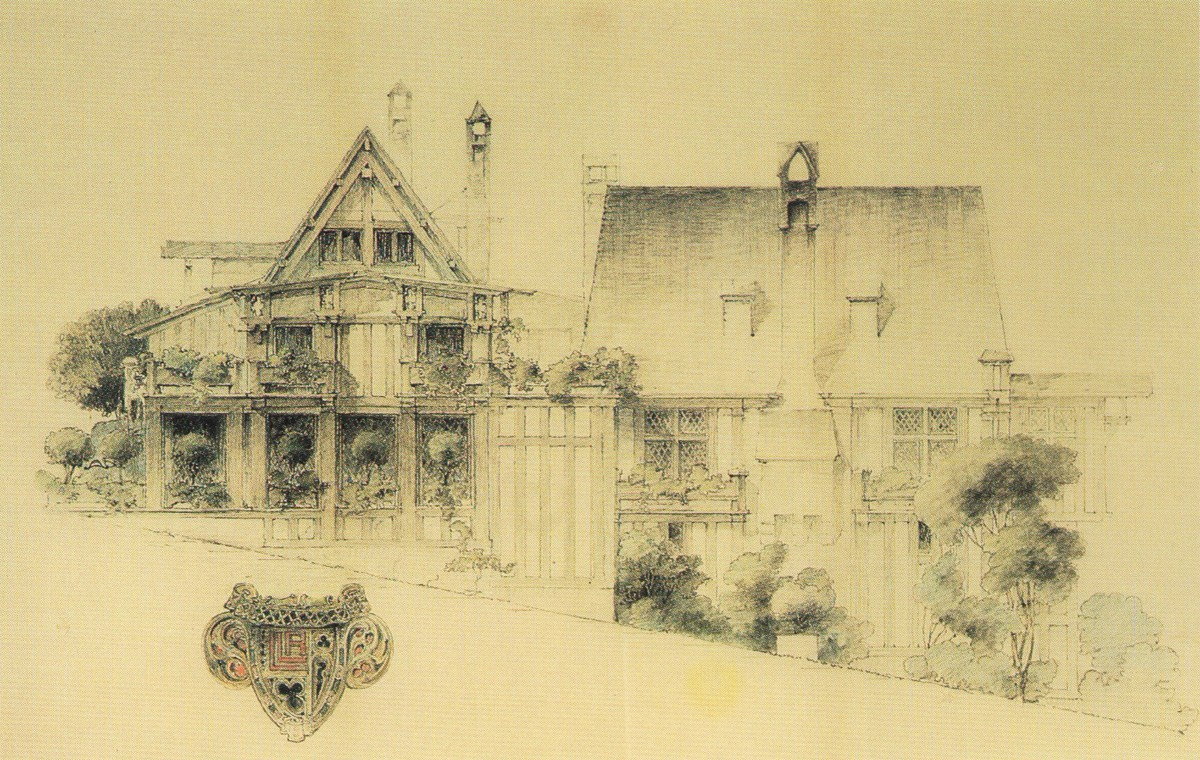
Maybeck’s presentation drawing of the Roos house, with the family crest.
A Mathews mural is in limbo
October 15, 2017 § 1 Comment
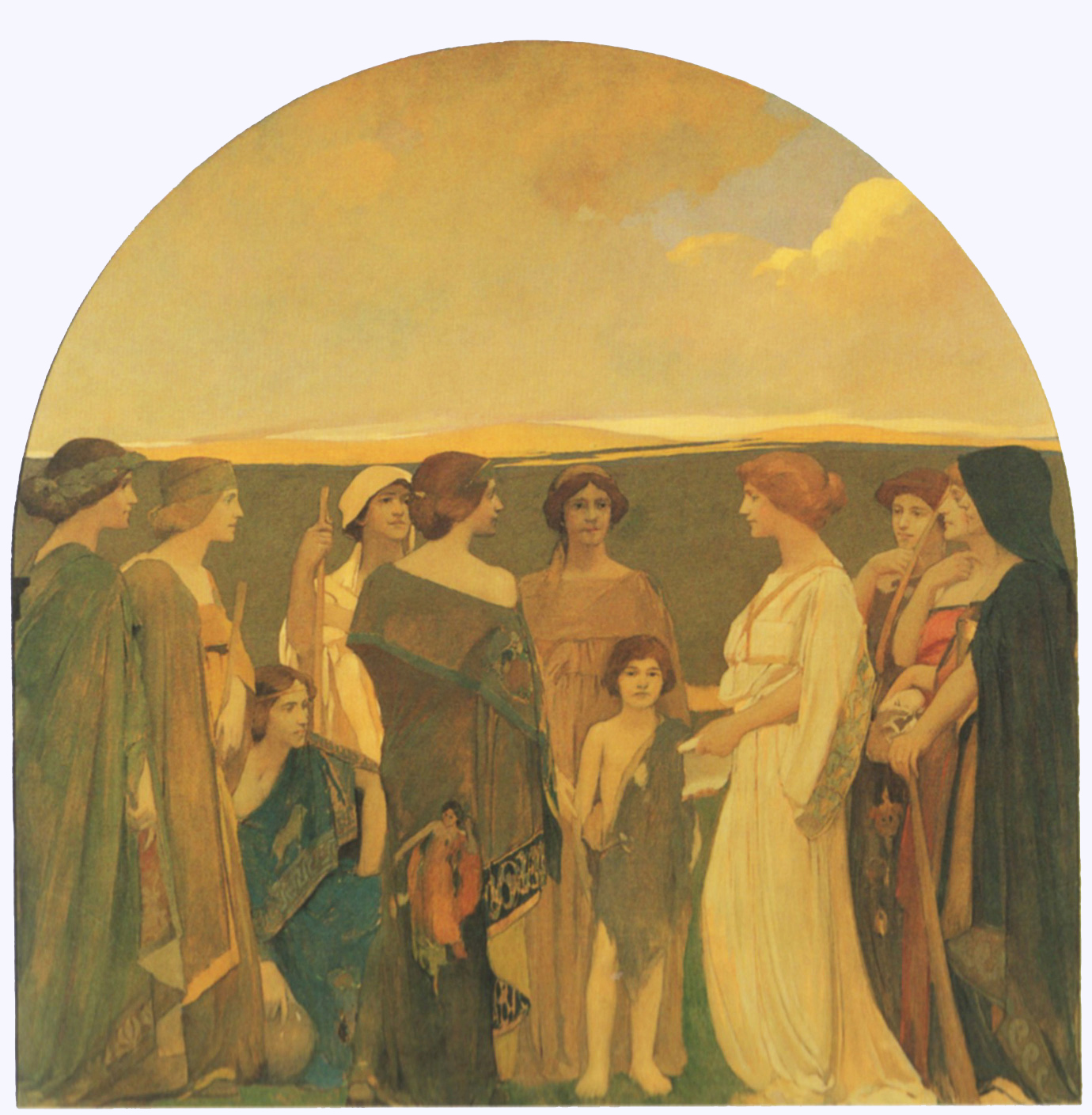
The center panel includes Apollo and the muses, plus Hygeia, goddess of health.
ARTHUR MATHEWS CREATED his three-panel mural Health and the Arts in 1912 for what is now the Health Sciences Library in San Francisco. It has hung there for more than a century. Now the library has gone digital, disposed of its books and put its classical home in Pacific Heights on the market, leaving the fate of the mural uncertain.
The mural was commissioned for the reading room of the library’s classical home, designed by architect Albert Pissis. Mathews at the time was perhaps California’s most important artist, and one who exerted considerable influence over the education of a generation of early California artists and the rebuilding of San Francisco after the 1906 earthquake and fire. Other murals by Mathews include a series of 12 panels tracing the history of California in the rotunda of the State Capitol in Sacramento.
A spokesman for the library said “it is too early to tell” about the fate of the mural and that it “depends on a buyer’s intended use for the building.” The Beaux Arts building is being marketed as a “one-of-a-kind development opportunity.”
“Although the murals could be removed, it would be a costly conservation process that would make them even more difficult to sell,” said Harvey Jones, the longtime curator who built the Oakland Museum’s expansive collection of work by Arthur Mathews and his wife, the equally talented artist Lucia Mathews. “It seems unlikely that a new owner will be able to utilize the murals in a new configuration of the spaces. Their artistic appeal is dubious to contemporary business sensibilities.”
Jones, author of The Art of Arthur & Lucia Mathews, added: “I wish there were some reasonable possibilities for optimism here.”
MORE: “Medical library is on the block”
Maybeck, meet Frank Lloyd Wright
December 15, 2016 § Leave a comment

Bazett House, 1939, Frank Lloyd Wright Archive
IN 1939, after seeing his Hanna House at Stanford, Sidney and Louise Bazett retained legendary architect Frank Lloyd Wright to design a new house for them nearby in Hillsborough, south of San Francisco.
When construction began the next year, the Bazetts agreed to Wright’s request that one of his apprentices, Blaine Drake, come to the site during construction to supervise and make sure Wright’s intentions were being carried out — with the apprentice to be housed and fed by the Bazetts.
Even during construction, the house was already attracting attention, and another legendary architect stopped by to take a look. As the roofs were being finished, Blaine Drake reported to Wright: “Bernard Maybeck, the architect, was over to see the house — he was both puzzled and intrigued.”
— From Frank Lloyd Wright and San Francisco by Paul V. Turner
Cradle of Arts & Crafts
September 21, 2016 § Leave a comment
A TOUR OF the Swedenborgian Church in San Francisco, birthplace of the Arts & Crafts movement in the United States.
Continuing the Arts & Crafts tradition
August 20, 2015 § Leave a comment
By MELATI CITRAWIREJA
Berkeleyside
Audel Davis and his wife, Lynne, live in a home tucked down a shady street off University Avenue in Berkeley. Apart from a few pesky crows that terrorize their coi fish by day, they have created a lush and quiet sanctuary, greatly influenced by the philosophy and aesthetics of the Arts and Crafts movement — a concept that took flight and reached its peak in the 1890s as a reaction to the age of mass production. It emphasized traditional craftsmanship as a way to put integrity and skill back into the design and manufacturing process.
Davis is a Bay Area coppersmith, widely known for his Arts and Crafts style lamps that have his own added twist.
Lessons in stained glass
January 31, 2015 § Leave a comment
FIRST PERSON | DOUGLAS G. STINSON
Like many people, I had been active in church life from childhood into early adolescence. Then, confronting what my teenaged mind saw as cowardice and hypocrisy within my church, I swore off religion.
In college I became aware of the writings of the 18th century scientist and Christian mystic Emmanuel Swedenborg and, as a scientist, was drawn to his insistence that the teachings of faith and reason must conform. But I had no interest in being part of any organized religion.
Until I walked into the San Francisco Swedenborgian Church.
I was awestruck by the building’s humble strength and simple beauty. Everything breathed a spiritual essence. I knew I wanted to be a part of it.
By 2012, the condition of the stained glass windows that had graced the Swedenborgian church at the corner of Lyon and Washington Streets for more than 100 years had deteriorated. We learned that if action were not taken, the beautiful windows — an integral part of the National Historic Landmark — could be lost forever.


